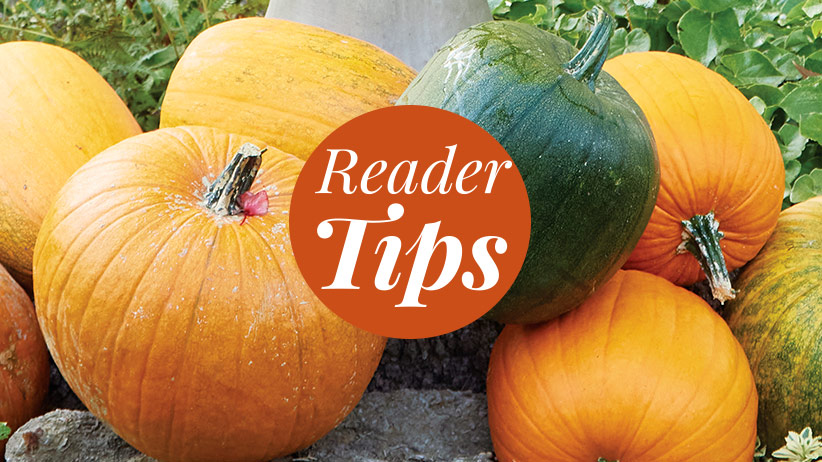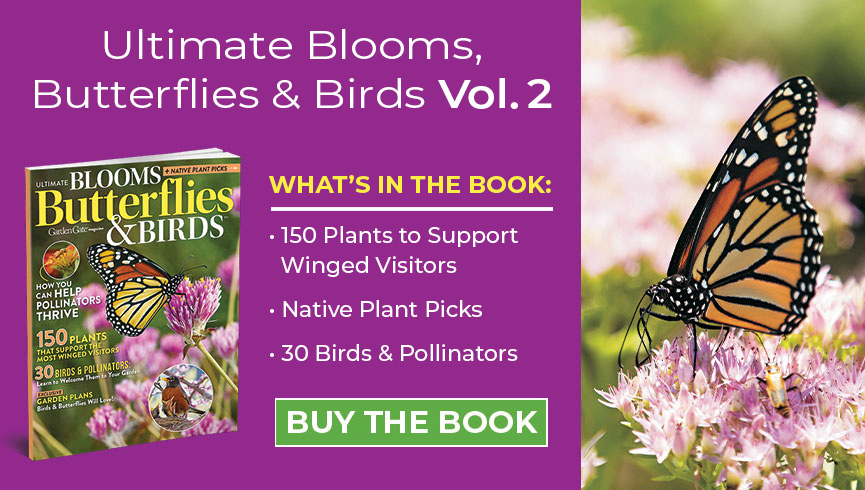Dreaming of summer
Unless you are lucky enough to live where it’s warm year round, when winter starts to drag on, it may feel as if the garden is awash in dreary, monochromatic browns and grays. Time to close your eyes and dream of summer—a colorful season when foliage is vibrant, flowers are blooming and pollinators are active.
If you need a bit of summer inspiration, here are three colorful low-maintenance combos that will also attract wildlife. Who wouldn’t dream of that?

Blue and orange flowers attract butterflies
Even if you aren’t a Denver Broncos fan, you’ll cheer for this eye-popping color combination. And butterflies will applaud it too. Heat-tolerant ‘Blue Butterfly’ Siberian larkspur will draw in many pollinators until late summer. Cut the bloom stalks to the ground when they are finished to keep plants neat.
Deadhead spent coneflower and bachelor’s button blossoms to extend flowering until fall, but leave a few to produce seeds that will grow the next year. ‘Karl Foerster’ feather reed grass is sterile and won’t reseed, but the dried seedheads provide winter interest and cover for birds. This drought-tolerant combo appreciates a midsummer boost of water-soluble general-purpose fertilizer.
Plant list
A) Siberian larkspur (Delphinium grandiflorum ‘Blue Butterfly’)
Perennial; royal blue flower spikes from early to late summer; full sun; 12 to 15 in. tall and wide; cold hardy in USDA zones 3 to 7
B) Coneflower (Echinacea ‘Cheyenne Spirit’)
Perennial; daisylike flowers in shades of orange, cream, yellow, red or purple from summer through fall; full sun to part shade; 22 to 30 in. tall, 12 to 24 in. wide; cold hardy in USDA zones 4 to 9
C) Feather reed grass (Calamagrostis x acutiflora ‘Karl Foerster’)
Perennial; wheat-colored flowers form in summer, seedheads persist into fall; full sun; 3 to 5 ft. tall, 2 to 3 ft. wide; cold hardy in USDA zones 5 to 9
D) Bachelor’s button (Centaurea cyanus ‘Blue Boy’)
Annual; blue flowers on long stems from early to late summer; full sun; 24 to 30 in. tall, 9 to 12 in. wide
You Might Also Like:
Monarchs and Milkweeds video
Pollinator Garden Plan Superbundle
5 Ways to Bring More Butterflies to Your Garden

Bird and butterfly favorites
Butterfly weed, an essential host plant for monarch butterfly larvae, anchors this richly colored summer planting. Penstemon and yarrow offer nectar for the mature butterflies, so deadhead faded flowers throughout the summer to extend their bloom time. Complementary purple blooms of spike blazing star will open in midsummer and attract pollinators. Leave spent flowers for seeds to form — goldfinch and other seed-loving birds will thank you.
Plant list
A) Butterfly weed (Asclepias tuberosa)
Perennial; orange flower clusters from early to late summer; full sun; 12 to
36 in. tall, 12 to 18 in. wide; cold hardy in USDA zones 3 to 9
B) Penstemon (Penstemon digitalis ‘Husker Red’)
Perennial; white flowers with a pink blush on tall spikes above burgundy to dark green foliage from late spring to early summer; full sun; 24 to 36 in. tall, 12 to 24 in. wide; cold hardy in USDA zones 3 to 9
C) Yarrow (Achillea ‘Firefly Peach Sky’)
Perennial; peachy orange flower clusters age to yellow from early to late summer; full sun; 32 to 36 in. tall, 28 to 32 in. wide; cold hardy in USDA zones 3 to 8
D) Spike blazing star (Liatris spicata)
Perennial; purple, pink or white flower spikes early to midsummer; full sun to
part shade; 18 to 48 in. tall, 12 to 24 in. wide; cold hardy in USDA zones 3 to 8

Shade-loving perennial border
Weeds can’t get a foothold in this tightly packed border of shade-loving perennials. But the stones exposed by these compact, mounded plants invite you to step into the garden. Deer-resistant lady’s mantle and coral bells need little care — just shear off or rake out dead foliage in early spring. Deadheading the coral bells, lady’s mantle and dalmation bellflower when blooms are spent will help plants look tidy through the summer. If the sedum starts to creep out over the path, use garden shears to keep it in line.
A) Coral bells (Heuchera hybrid)
Perennial; spires of tiny red, pink or white flowers over mounded foliage from late spring to summer; full sun to part shade; 6 to 24 in. tall, 10 to 36 in. wide; cold hardy in USDA zones 3 to 9
B) Lady’s mantle (Alchemilla mollis)
Perennial; airy lime-green flowers over mounded chartreuse foliage from late spring to early summer; full sun to part shade; 10 to 18 in. tall, 18 to 30 in. wide; cold hardy in USDA zones 4 to 8
C) Dalmatian bellflower (Campanula portenschlagiana)
Perennial; small blue or violet bell-shaped flowers in late spring; full sun to part shade; 8 to 12 in. tall, 12 to 24 in. wide; cold hardy in USDA zones 4 to 8
D) Sedum (Sedum rupestre ‘Angelina’)
Perennial; yellow flower clusters on a mat of chartreuse foliage from mid-to late summer; full sun to part shade; 4 to 6 in. tall, 12 to 24 in. wide; cold hardy in USDA zones 5 to 9
You Might Also Like:
Japanese Weeding Sickle
'Blue Boy' Bachelor's Buttons
Utility Snips
















